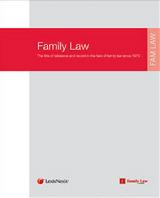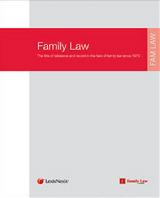- News & Comment
-
Online Shop
Online Services
Looseleafs
Law Reports
Books and eBooks
-
CPD & Events
Webinars
Events
- Authors
- About Family Law
- Contact












 13 JAN 2025
13 JAN 2025

 13 JAN 2025
13 JAN 2025

 12 JAN 2025
12 JAN 2025

 12 JAN 2025
12 JAN 2025

 12 JAN 2025
12 JAN 2025







Dr Mike Shaw, Consultant Child & Adolescent Psychiatrist & Co-director FDAC National Unit and Nick Isaacs, Consultant Child and Adolescent Psychiatrist London FDAC
In this seventh blog in our series of blogs about FDAC, we look at how children’s needs and timescales for children impact on the plan developed as part of the FDAC process.
An important feature of the FDAC model is the Children’s Needs Meeting, which helps the team determine whether children have an increased level of need. It also helps the parents understand more about their child’s needs, and discussions held at the meeting inform the work that FDAC team is doing with the parent as part of the Intervention Plan.
Where the Children’s Needs Meeting suggests that children have an increased level of needs, the FDAC child and adolescent psychiatrist or psychologist, will carry out an individual assessment and produce a report for the court. Normally we wouldn’t expect a letter of instruction, but sometimes the parties will agree one. The report will provide a detailed assessment of the children’s needs, any diagnosis, what treatment is needed and how this could be accessed. It will give an analysis of the potential cause of those needs and include where appropriate the child’s perspective. This will remove the need for an independent expert to be instructed.
Families come into care proceedings because children are suffering, or likely to suffer significant harm, and this is attributable to parental action or inaction. So the question becomes, how long can these children afford to wait for the situation to improve? The answer depends on the children’s age, developmental stage and level of needs. There are three developmental crossroads that are particularly important:
In FDAC the aim will be to have newborn babies permanently placed by their first birthday. This is because of the advantages of ‘early attachment’ to long-term health and life chances. The sensitive period when children naturally form an attachment is between 6 and 18 months, and 12 months is safely inside that sensitive period. The FDAC ethos is always to attempt to keep children with or return children to their parents, but if that is not possible, we regard an early attachment with a member of the extended family or with an adoptive parent as the next best option for children.
The FDAC team will advise the court whether or not the parents are on track to be meeting their babies’ needs by 12 months at around week 18-20 in the proceedings. If reunion is the most likely outcome the team will normally recommend the proceedings are extended beyond 26 weeks. Where babies are placed with a temporary carer who could also become a permanent carer (a relative who would be suitable for a Special Guardianship Order or an adoptive parent under ‘concurrency’ or ‘foster to adopt’ arrangement) children’s timescales can be extended because delay in finding a permanent carer will be avoided. Equally, where FDAC can work with pregnant mothers in pre-proceedings (available in some FDACs) parents have more time to make the necessary changes.
Where children pass through the sensitive period of 6-18 months without forming a healthy attachment, they can still form an attachment if they are placed with a good enough carer, but the quality of that attachment is likely to be impaired. If the child reaches the age of 3-4 years without forming a healthy attachment the risk of developing an attachment disorder rises rapidly (these are children characterised by either emotional withdrawal and failing to seek comfort or indiscriminate friendliness with adult strangers). It follows that time is running out for children aged 2-3 years with attachment difficulties or an attachment disorder, and they urgently need to be placed with long-term carers and can’t wait for their parents to change.
For example a 4-year-old boy who is over-friendly with strangers, eats excessively and is highly emotionally volatile, shows no signs of attachment to his parents or other family members. This is a ‘developmental emergency’. If he is permanently placed with a sensitive carer there is still a chance he can form an attachment and begin to settle, but time is running out!
While older children can manage short spells in foster care, after a certain age children find it difficult to put down roots in an unfamiliar substitute family and such placements are much more likely to breakdown. Older children feel a conflict of loyalty and want to protect their vulnerable parents. This means that permanently removing children beyond a certain age is less helpful. It is difficult to say when this age is, but it is somewhere around 8-10 years. Again, a lot depends on the level of children’s needs. Conversely, older children can wait a lot longer, but there is a limit to how long any child can live with the uncertainty of not knowing whether or not she will be returning home. In FDAC we think that limit is 12 months.
For example, a 12-year-old girl was placed with her maternal aunt at the start of proceedings. By week 18 in the proceedings her mother is making some progress but she is far from ready to have her daughter returned. The girl would prefer to be with her mother, but is happy with her aunt who has had a positive Special Guardianship assessment. In these circumstances, it might be better to bring proceedings to an end with an SGO to the aunt, encourage the mother to give herself another 18 months to work on her recovery, and give some thought on how the aunt, mother and daughter might be supported to review any progress that mother makes and consider whether return to mother is a realistic option at a later date.
A previous blog addressed What counts as a success in FDAC cases. Sometimes children’s level of needs and or timescales are not compatible with their parent’s journeys, in which case the best outcome will be ensuring children find alternative long-term placements without undue delay. In such cases, FDAC will also encourage parents to keep trying to overcome their difficulties so they can continue to play a role in their children’s lives and be able to care for future children.
The work of the National Unit and news from the FDAC sites is available at www.fdac.org.
You can follow theFDAC National Unit on Twitter @FDAC_NU
Leading practical guidance service, Lexis®PSL Family provides procedural and substantive guidance with suites of Practice Notes, Forms and Precedents covering all aspects of family law. Click here to request a free 1-week trial. Please quote: 100482.





Leave a commentOrder by
Newest on top Oldest on top